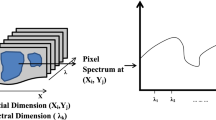Abstract
This paper will present a target classification system based on fuzzy automata to carry out better target classification, which deal with images first and then classify the objects. The system includes image preprocessing, feature extraction, target matching and classification. Compared with other existing methods, this paper utilizes the characteristics of aurora images and uses fuzzy automata to implement target classification. The simulation results show that the classification effect of the proposed method based on fuzzy automata is better than that of other classification methods. The correct classification rate is 94.66%, and its classification speed is 2.28 s.








Similar content being viewed by others
References
Zhang, Xiumei, Liu, Xikui, Li, Yan: Adaptive fuzzy tracking control for nonlinear strict-feedback systems with unmodeled dynamics via backstepping technique. Neurocomputing 235(26), 182–191 (2017)
Boles, W., Boashah, B.: A human identification technique using images of the iris and wavelet transform. IEEE Trans. Signal Process. 46(4), 1185–1188 (1998)
Pan, Haiyu, Li, Yongming, Cao, Yongzhi, Li, Ping: Nondeterministic fuzzy automata with membership values in complete residuated lattices. Int. J. Approx. Reason. 82(3), 22–38 (2017)
Pan, H., Li, Y., Cao, Y.: Lattice-valued simulations for quantitative transition systems. Int. J. Approx. Reason. 56(2), 28–42 (2015)
Pan, Haiyu, Cao, Yongzhi, Zhang, Min, Chen, Yixiang: Simulation for lattice-valued doubly labeled transition systems. Int. J. Approx. Reason. 55(6), 797–811 (2014)
Smith, Stephen M.: Susan—a new approach to low level image processing. Int. J. Comput. Vis. 23(1), 45–78 (1997)
Zheng, N.-N.: Computer Vision and Pattern Recognition. National Defence Industry Publishing Company, Beijing (1998). (book)
Qin, Q.-Q., Yang, Z.-K.: Practical Wavelet Analysis. XiDian University Publishing Company, Xi’an (1994). (book)
Nobuhara, Hajime, Bede, Barnaba′s, Hirota, Kaoru: On various eigen fuzzy sets and their application to image reconstruction. Inf. Sci. 176(2), 2988–3010 (2006)
Sung-Kwun, Oh, Pedrycz, Witold, Roh, Seok-Beom: Genetically optimized fuzzy polynomial neural networks with fuzzy set-based polynomial neurons. Inf. Sci. 176(2), 3490–3519 (2006)
Reed, T., Hans De Buf, J.M.: A review of recent texture segmentation and feature extraction techniques. Comput. Vis. Gr. Image Process. Image Underst. 57(3), 359–372 (1993)
Pal, S.K., Mitras, S.: Noisy fingerprint classification using multilayer perceptron with fuzzy geometrical and textural features. Fuzzy Sets Syst. 2(80), 121–132 (1996)
Tan, T.N.: Texture edge detection by modeling visual cortical channels. Pattern Recogn. 28(9), 1283–1298 (1995)
Li, Y.M., Wang, Q.: The universal fuzzy automaton. Fuzzy Sets Syst. 249(1), 27–48 (2014)
Jin, Jianhua, Li, Qingguo, Li, Yongming: Algebraic properties of L-fuzzy finite automata. Inf. Sci. 234(5), 182–202 (2013)
Lihua, Wu, Qiu, Daowen, Xing, Hongyan: Automata theory based on complete residuated lattice-valued logic: turing machines. Fuzzy Sets Syst. 208(7), 43–66 (2012)
Hang, Su, Zhang, Tianliang, Zhang, Weihai: Fuzzy adaptive control for SISO nonlinear uncertain systems based on backstepping and small-gain approach. Neurocomputing 238(17), 212–226 (2017)
Hang, Su, Zhang, Weihai: A combined backstepping and dynamic surface control to adaptive fuzzy state-feedback control. Int. J. Adapt. Control Signal Process. 31(11), 1666–1685 (2017)
Acknowledgements
This work is supported by Henan Province Outstanding Youth on Science and Technology Innovation (No. 164100510017); National 973 Program (No. 613237); National Natural Science Foundation of China (Nos. 61501407, 61503173), respectively.
Author information
Authors and Affiliations
Corresponding author
Rights and permissions
About this article
Cite this article
Gao, Z., Wu, Q., Chen, H. et al. Target Classification by Constructing Fuzzy Automata System. Int. J. Fuzzy Syst. 20, 2620–2631 (2018). https://doi.org/10.1007/s40815-018-0494-3
Received:
Revised:
Accepted:
Published:
Issue Date:
DOI: https://doi.org/10.1007/s40815-018-0494-3




